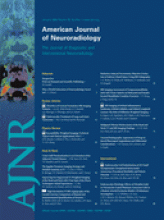Abstract
BACKGROUND AND PURPOSE: The benefit of recanalization in basilar artery occlusion (BAO) has been established. The baseline extent of brain stem damage may also influence the outcome. We investigated whether a baseline diffusion-weighted imaging (DWI) score may provide additional prognostic value in BAO.
MATERIALS AND METHODS: We analyzed baseline clinical and DWI parameters in consecutive patients treated with endovascular procedures for acute BAO. Brain stem DWI lesions were assessed by using a semiquantitative score based on arterial territory segmentation. Outcome at 3 months was dichotomized according to the modified Rankin Scale (mRS) as favorable (mRS, 0–2) or unfavorable (mRS, 3–6). Spearman rank correlation tests assessed the correlation between DWI and clinical variables. Univariate and multivariate logistic regression analyses were used to identify clinical and MR imaging predictors of outcome.
RESULTS: Twenty-nine patients were included. The brain stem DWI score (median, 3; range, 0–14) was correlated with the baseline National Institutes of Health Stroke Scale (NIHSS) score and the presence and length of coma (r = 0.67, 0.49, and 0.53, respectively; P < .01). Recanalization was achieved in 76%. A higher baseline NIHSS score (P = .02) and brain stem DWI score (P = .03), a lower Glasgow Coma Scale score (P = .04), and the presence of coma (P = .05) were associated with poor outcome in univariate analysis. Multivariate analysis showed that the brain stem DWI score was the only independent baseline predictor for clinical outcome (P = .026).
CONCLUSIONS: Baseline brain stem DWI lesion score is an independent marker of outcome in BAO.
- Copyright © American Society of Neuroradiology












